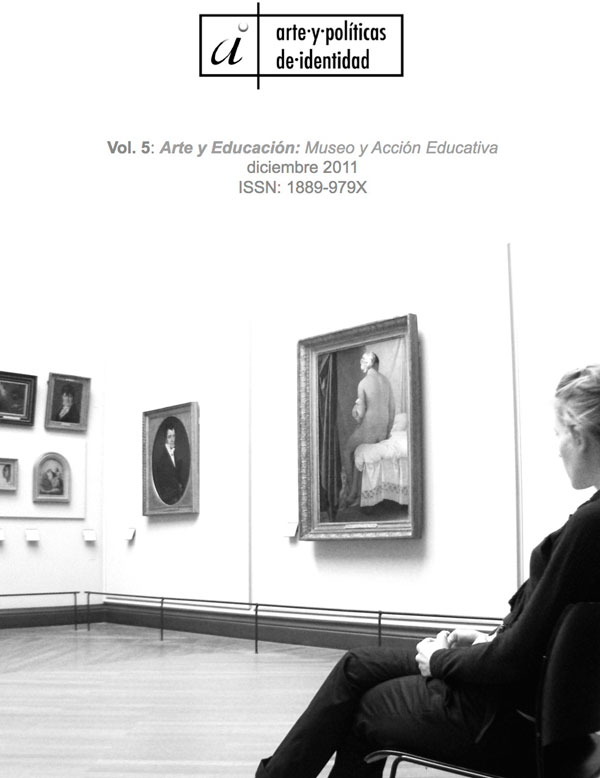Feminism or Need?: The Artistic Process in the Work of Eve Hesse and Ana Mendieta
Abstract
This paper reflects on the art as a therapeutic need to mitigate the inevitable wounds of the female artist. She is usually catalogued as·“active feminist”, because of the human endeavour to establish taxon in all areas. If you are a creative, committed woman whose work takes place on the second decade of the twentieth century, there is no problem to attach this label. If further along her history there appears a dominant male figure, which is more than likely, our fears are completely mitigated.
All these simplifications do not miss the truth in the strict sense, but are not quite beneficial if w take into account they assume the omission of other equally meaningful and enriching aspects. As examples of multiple and often muted critical analysis, we have chosen Eva Hesse and Ana Mendieta, two artists with a short productive life who knew they could channel their fears through their work, through which they found a way out.
Downloads
-
Abstract1405
-
PDF (Español (España))1193
References
Art in Process IV. (December 1969–January 1970). New York City: Finch College Museum of Art, Contemporary Wing.
Beauvoir, S. (1949). El Segundo sexo. Buenos Aires: Editorial Siglo Veinte.
Beckett, S. (1990). El mundo y el pantalón. En Manchas en el silencio. Barcelona: Ed. Tusquets.
Blocker, J. (1999). Where’s Ana Mendieta? Identity, Performativity and Exile. Durham and London: Duke University Press.
---------(2002). Where’s Ana Mendieta? En M. Ruido (Ed.), Ana Mendieta. Colección Arte Hoy. San Sebastián: Editorial Nerea.
Castro Flórez, F. (1996) En el umbral de la ayección. En ¿Deshumanización del arte?Salamanca: Ediciones Universidad de Salamanca.
Chicago, J. y Schapiro, M. (1973). Female Imagery. Womanspace Journal, 1, 11-14.
Eva Hesse. Página oficial de la artista. Disponible en http: www.evahesse.com
Fer, B. (2007). Eva Hesse and color. October 119, 21-36.
Hesse E. (2006). Datebooks, 1964/65 (A facsimile Edition). New Haven and London: Yale University Press.
Hernádez-Navarro, M.A. (2006). El arte contemporáneo entre la experiencia, lo antivisual y lo siniestro. Revista Occidente, 297, 7-25.
Homans, M. (1986). Bearing the Word. Chicago: University of Chicago Press.
Larrea Príncipe, I. (2007). El significado de la creación de tejidos en la obra de mujeres artistas. Tesis Doctoral. Facultad de Bellas Artes. Universidad del País Vasco.
Lippard L. (1976). Eva Hesse. New York: University Press.
López-Cabrales, M. (2006). Laberintos corporales en la obra de Ana Mendieta. Revisado el 2 de enero, 2012, de http://www.ucm.es/info/especulo/numero33/laberint.
Merleau-Ponty, M. (1985). Fenomenología de la percepción: el cuerpo. Barcelona: Planeta Agostini.
Moure, G. (Ed.) (1996). Ana Mendieta. Barcelona: Polígrafa.
Nemser, C. (1970). A Interwiew with Eva Hesse. Artforum 8 (9), 59-63.
Petzinger R. and Rosen B. with Spohn A. (Eds). (2006). Eva Hesse: Catalogue Raisonné. Volume 1: PAINTING. New Haven, Fall: Yale University Press.
Petzinger R. and Rosen B. with Daur J. (Eds). (2006). Eva Hesse: Catalogue Raisonné. Volume 2: SCULPTURE. New Haven, Fall: Yale University Press.
Sussman, E. y Wasserman, F. (2006). Eva Hesse. New Haven and London: Yale University Press.
Wagner, A.M. (2002). Another Hesse. En Another Hesse 1996 del libro Eva Hesse, Mignon Nixon ed., Library of Congreso Cataloging-in-Publication Data, October Files.
Works published in this journal are subject to the following terms:
- The Service of Publications from the University of Murcia (publishing house) keeps the published works’ copyrights, and favors and allows the reuse of these works under the license indicated in point 2.
- Works are published in the journal’s online edition under the license Creative Commons Reconocimiento-NoComercial-SinObraDerivada 3.0 España(texto legal). They can be copied, used, disseminated, transmitted and publicly exhibited, as long as: i) the author and original source of publication are cited (journal, publishing house and work’s URL); ii) they are not used for commercial purposes; iii) the existence and specifications of this license are mentioned.
3. Conditions for auto-file. It is allowed and encouraged that authors share electronically their pre-print version (the pre-reviewed version) and /or post-print version (the reviewed and accepted version) of their Works before the publication, since it promotes its circulation and dissemination. RoMEO color: green.










